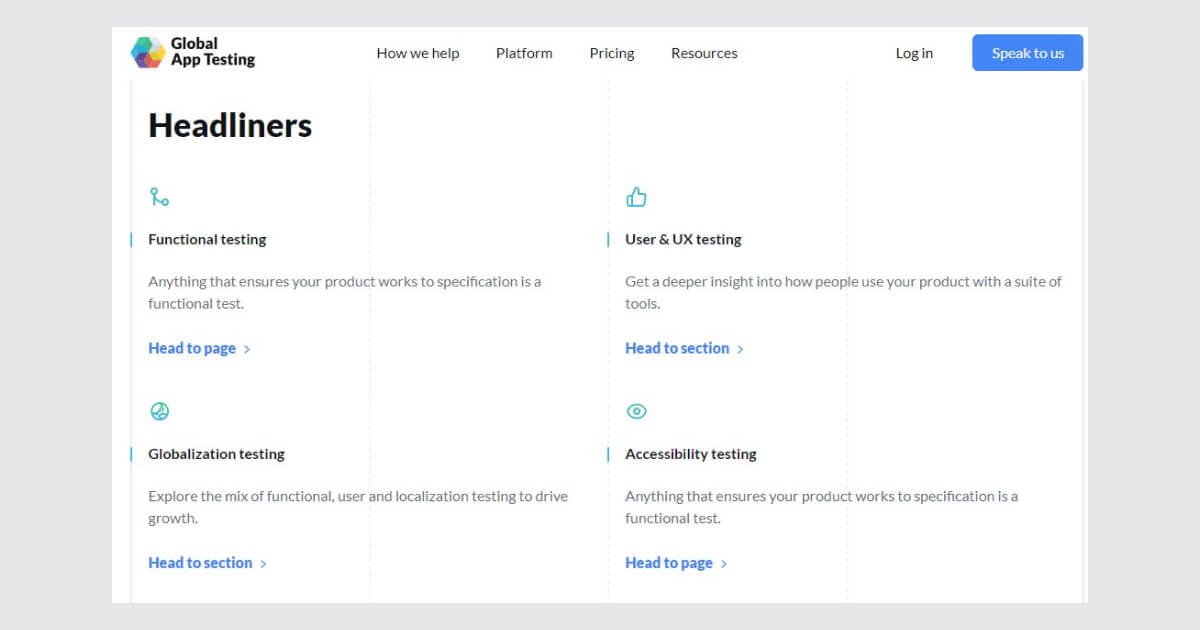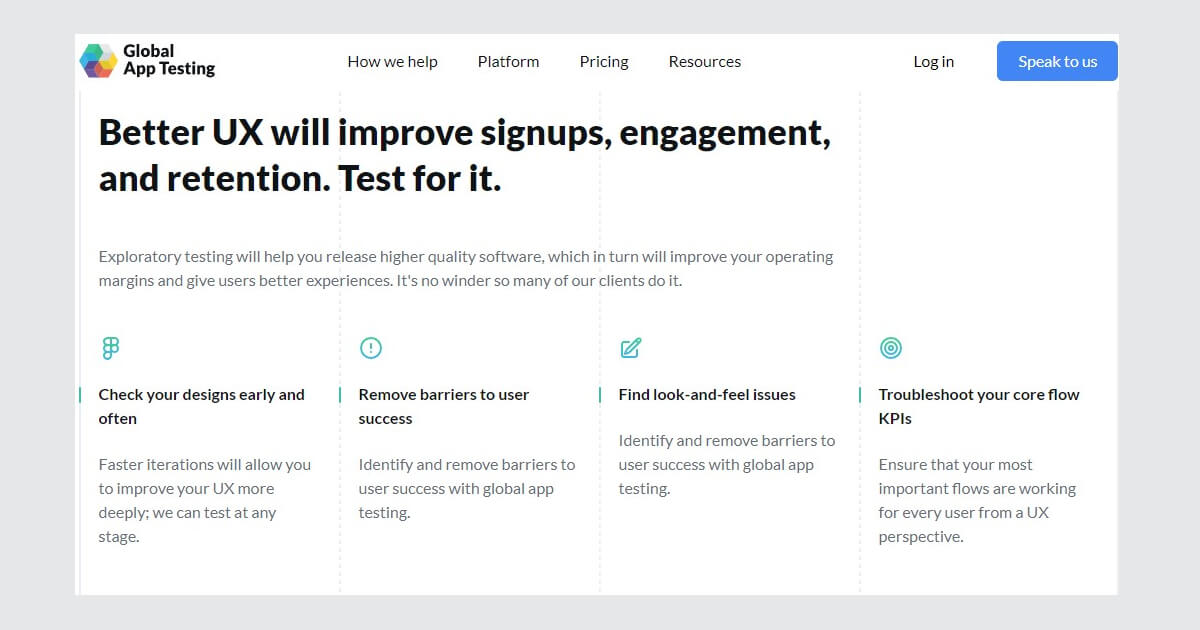10 Types of web application testing
The variety of testing types for web apps demonstrates the complexities of creating a dependable, user-friendly, and secure online presence. Each type of web application testing focuses on a particular aspect of the app, such as its functionality, performance, security, or ease of use.
These strategies are extremely useful in detecting and resolving difficulties early on, playing a critical part in improving the overall quality of the web app. For developers who want to design high-quality web apps, a thorough understanding and execution of these many testing methodologies is required. Read along to find out 10 types of web application testing, why they are important, and when to use them to ensure the effectiveness of the testing process.
We can help you drive global growth, better accessibility and better product quality at every level.
Benefits of web application testing
Web application testing is essential for a high-quality product for many reasons. Here are a few benefits to consider:
- Improved functionality: Testing ensures that your web application is working as expected and that there are no errors or bugs that could negatively impact the user experience.
- Enhanced security: By testing your web application, you can identify vulnerabilities and take corrective actions to prevent potential threats.
- Increased performance: Testing can reveal any performance issues that could cause slow load times or other concerns impacting user satisfaction.
- Cost Savings: Testing helps you catch problems early on, saving time and money by avoiding costly errors later.

Approaches to web application testing
Web application testing involves automated and manual approaches to assess functionality and performance thoroughly.
Automation testing
Automation testing is a popular approach to testing web applications that has gained much attention and popularity in recent years. This approach involves using software tools to perform tests that would otherwise be conducted manually. With automation, tests can be executed faster and more accurately, reducing the likelihood of human error.
The automation testing benefits include faster test results, improved test coverage and consistency, and greater efficiency. Additionally, automation testing tools can capture and store detailed test results, making identifying and fixing any issues easier before they become more significant problems.
Manual testing
With manual testing, testers manually execute test cases without using automated software tools. Manual testing is valuable in cases where a deeper understanding of the application's behavior is required and human judgment needs to be applied. It is also helpful in uncovering user experience issues, identifying edge cases, and exploring testing scenarios not covered by automated tests.
However, manual testing can be time-consuming, prone to human error, and is often not scalable for large projects with frequent software releases. Manual testing is also vulnerable to bias due to the testers' unconscious beliefs, meaning the interpretation of test results may vary from person to person.
Pro Tip
Global App Testing services leverage advanced software tools and technology to perform a wide range of tests quickly and efficiently. With 90,000 testers in 190+ countries, GAT uses both, automated and manual testing to identify any issues with your web application.

Global App Testing provides the most comprehensive testing solution by conducting all possible testing scenarios for a web application.
Challenges in web application testing
Web application testing is crucial for ensuring web applications' quality, security, and reliability. However, there are several challenges that testing teams must overcome to achieve these goals:
- Browser compatibility: With many different browser types, versions, and devices available, browser compatibility testing presents a significant challenge for web application testing.
- Test environment stability: Maintaining consistent test environments can be difficult, making it harder to reproduce bugs and errors found during testing.
- Test data management: As data is used to test an application, there needs to be adequate management of how this data is used, shared, and secured.
- Testing scalability: Web applications have a lot of components that require testing, making it challenging to scale testing in a way that keeps pace with development timelines.
- Security testing: One of the most critical challenges of web application testing is ensuring the application is secure and protected from vulnerabilities such as SQL Injection, XSS, CSRF, etc.
10 types of web application testing you should know about
Web application testing falls into two main categories: functional testing, which examines core features, and non-functional testing, which assesses performance, security, and usability. Let’s explore other types of web application testing.
Functional testing
Within functional testing, we break down the evaluation into crucial phases: unit testing, integration testing, system testing, regression testing, and acceptance testing.
Unit testing
Typically, unit testing is performed during the development stage, where developers create a piece of code (unit) and then test its functionality to detect errors or bugs. Testing individual code units allows developers to pinpoint and swiftly address any failures, ensuring efficient resolution and identifying the root cause. Unit testing can help catch coding errors early, reduce the time and effort required for manual testing, and improve code design by identifying design issues earlier.
Integration testing
Integration testing involves combining individual software modules and testing them as a group to verify their harmonious and intended functionality. Integration testing aims to detect any differences or inconsistencies in how the modules interact as they are combined. Integration testing can be done in several ways, including Big Bang, Top-Down, or Bottom-Up approaches, depending on the preference of the testing team. One of the most significant benefits of integration testing is that it tests the interface between modules, allowing bugs or errors to be detected, which would not be found in unit testing.
System testing
System testing is a phase that validates a complete and integrated web application to verify that it meets all specified requirements. System testing aims to test the end-to-end functionality of the system and how it interacts with other systems in its environment. System testing encompasses diverse types of testing, including functional, non-functional, performance-based, and usability testing, and focuses on testing the entire system's behavior and reliability.
End-to-end scenarios are tested in system testing to emulate realistic user behavior, clearly showing how the user will interact with the system. One key benefit of system testing is identifying defects early in the testing process, reducing the cost and time delays associated with fixing issues discovered later in the development cycle.
Regression testing
Regression testing aims to identify issues in previously tested code or configurations after changes or modifications. This type of testing ensures that updates or modifications do not cause a conflict with the existing functionalities of the web application. Regression testing can be both time-consuming and resource-intensive because it requires a balance of manual and automated testing.
Acceptance testing
Acceptance testing evaluates and validates the web application's functionality from an end-user perspective. This testing approach confirms whether the web application has met the business's agreed-upon requirements. Business analysts and end-users often perform this process to ensure that the delivered web application meets their needs and requirements.
Acceptance testing is conducted after the web application has gone through all levels of testing and is ready for release. It involves testing the web application's user interface, usability, security, compatibility, performance, and reliability.
Non-functional testing
Turning our focus to non-functional testing, we segment the assessment into key areas: UI, usability, performance, compatibility, and security.
UI testing
UI (User Interface) testing is a process that checks whether the web application's user interface works as intended and is visually appealing to the end-users. This type of testing involves validating that web pages, forms, buttons, and other visual elements are correctly displayed and their functions work as expected.
UI testing includes testing the user interface design and layout, responsiveness, and compatibility across multiple devices and screen sizes. Through UI testing, developers and testers can catch errors and defects, such as poor layout, error messages, or typos, that might impact the user experience.
Usability testing
Usability testing involves collecting customer feedback, observing how they interact and navigate the web application, and identifying usability issues. Usability testing is crucial to web application testing as it focuses on the user's needs, wants, and expectations. Testers can improve the web application's usability by observing and analyzing how the end-users engage with the software.
Usability testing can improve user satisfaction, reduce training costs, and boost users' productivity. By considering the feedback the end-users give, developers can enhance the web application's user interface (UI), improve the user experience (UX), and increase the web application’s adoption rate. This type of testing can be done at any stage of web application development.
Pro Tip
Global App Testing offers usability testing as one of the core elements of web application testing. With UX and usability testing, we can help you check your application for any possible issues in 48 hours or less.
Better UX improves signups, engagement, and retention, so considering usability and UX testing are crucial to improving your product's overall quality.
Performance testing
Performance testing evaluates a web application's speed, stability, and scalability under varying user loads and network conditions. This type of testing helps identify and eliminate bottlenecks in the application, ensuring that it can handle many users without compromising its stability and response time. Performance testing ensures the application meets its requirements and provides a seamless user experience.
Compatibility testing
Compatibility testing is designed to verify that a web application can function correctly across different web browsers or operating systems, regardless of the device or platform that is used to access the application. Compatibility testing covers various areas, including functional, visual, and performance compatibility testing. By conducting compatibility testing, developers can identify issues related to cross-browser compatibility, hardware compatibility, and other problems that could affect the user experience.
Security testing
Security testing identifies the application's vulnerabilities, weaknesses, and security flaws and ensures that the data is secure from unauthorized access. This type of testing involves identifying potential security threats and risks with the goal of preventing data breaches that could compromise the confidentiality, integrity, and availability of sensitive information. Security testing covers many areas, including network security, access control, data protection, and authentication. By conducting security testing, web developers can identify and address security vulnerabilities before cybercriminals exploit them. This testing guarantees the application's security and establishes a safe environment for user data.
How can GAT help you release a high-quality web application?
The importance of web app testing cannot be overstated. It ensures functionality, enhances user experience, and safeguards against potential issues, leading to a top-notch web app your customers will enjoy. Global App Testing (GAT) assists in achieving these goals through:
- Comprehensive testing: GAT covers functional, usability, accessibility, localization, and compatibility testing.
- Global reach: Test across various devices and countries for a broader understanding of user experience.
- Quick turnaround: Receive timely results for faster improvements and decision-making.
Integration with workflows: Seamlessly integrates with existing development workflows. - Quality Assurance: Helps identify critical bugs and enhances the overall user experience.
Do you want to transform your app's potential into reality? Let's schedule a call to learn more about how you can elevate your web app to global standards with Global App Testing.
We can help you drive localization as a key initiative aligned to your business goals
FAQ
Why is web application testing important?
Web application testing is vital for ensuring functionality, usability, security, and performance. It identifies and addresses issues, enhancing the user experience and maintaining application reliability.
What role does performance testing play in web application testing?
Performance testing evaluates how well the application performs under different conditions, such as heavy traffic or high loads. It ensures optimal functionality, responsiveness, and reliability even during peak usage.
How does security testing contribute to web application quality assurance?
Security testing identifies and addresses potential vulnerabilities within the application, preventing unauthorized access and data breaches. It is integral for maintaining the confidentiality, integrity, and availability of sensitive information.
Keep learning
5 Best practices for testing web applications
The only software testing checklist you need
8 Best software testing blogs to follow in 2025

